CNA151 Case Study: Socio-Demographic and Health Determinants
VerifiedAdded on 2022/09/24
|8
|2031
|22
Case Study
AI Summary
This case study analyzes the socio-demographic characteristics and social determinants of health evident in a specific region. It examines the impact of factors like poor literacy, unemployment, and lack of healthcare on individuals' lives. The analysis identifies unemployment as a key social determinant and proposes strategies to address it at a population level, including promoting self-employment, agro-based industries, and skills training. The case study also explores the role of health professionals in addressing social determinants through adjustments to clinical care, connecting patients to resources, and advocating for policy changes. References from various researchers are provided to support the findings of the case study.
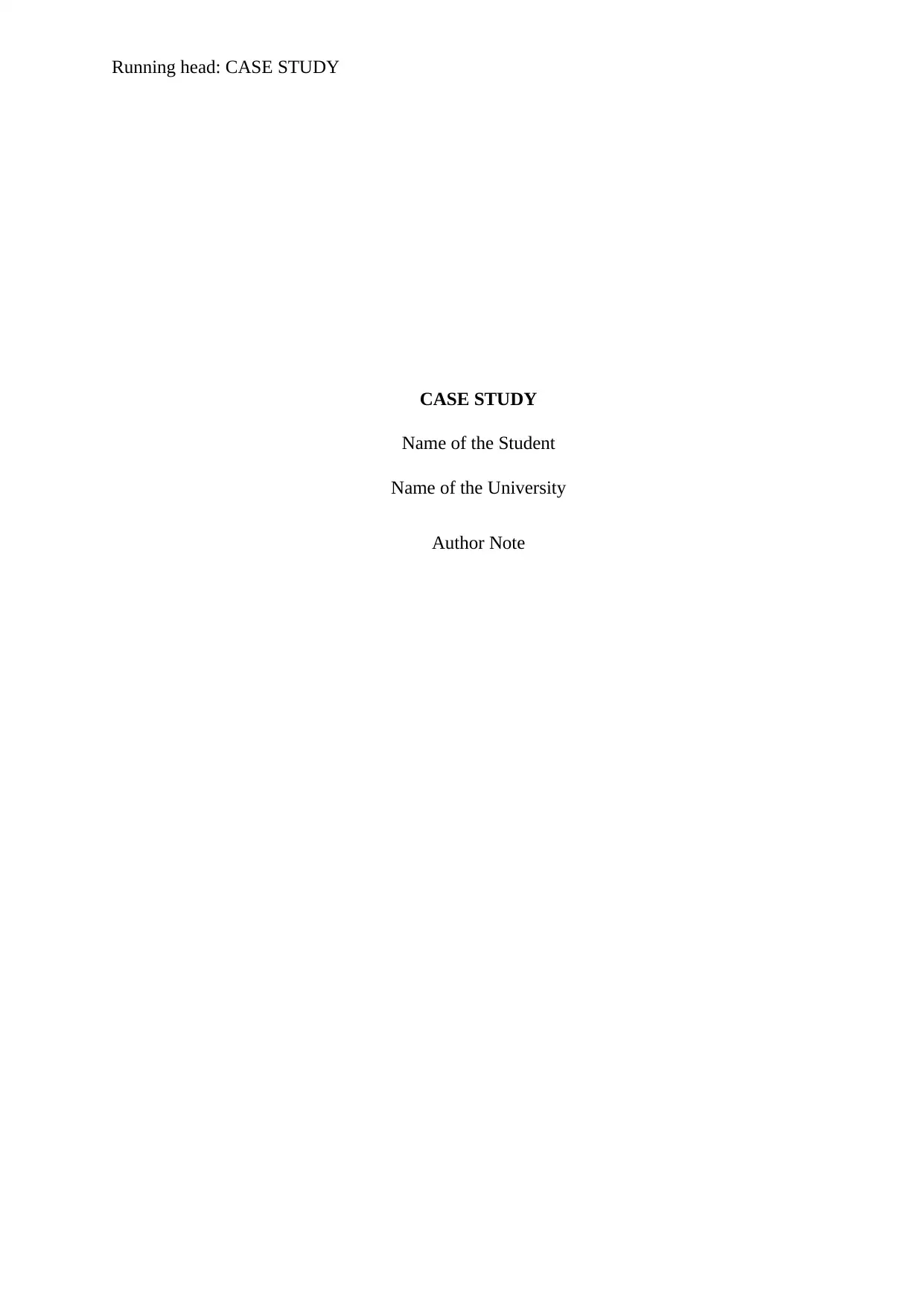
Running head: CASE STUDY
CASE STUDY
Name of the Student
Name of the University
Author Note
CASE STUDY
Name of the Student
Name of the University
Author Note
Paraphrase This Document
Need a fresh take? Get an instant paraphrase of this document with our AI Paraphraser
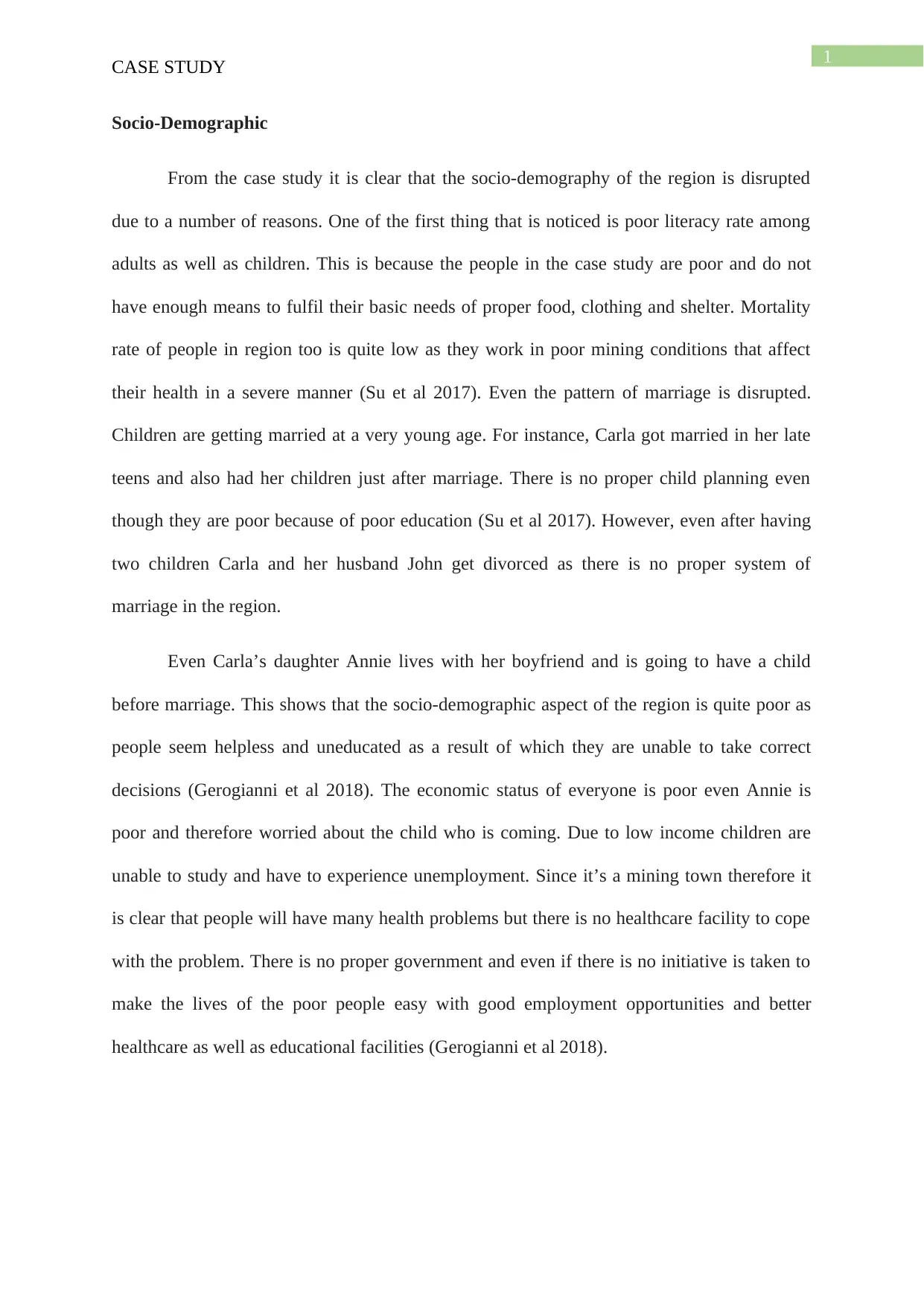
1
CASE STUDY
Socio-Demographic
From the case study it is clear that the socio-demography of the region is disrupted
due to a number of reasons. One of the first thing that is noticed is poor literacy rate among
adults as well as children. This is because the people in the case study are poor and do not
have enough means to fulfil their basic needs of proper food, clothing and shelter. Mortality
rate of people in region too is quite low as they work in poor mining conditions that affect
their health in a severe manner (Su et al 2017). Even the pattern of marriage is disrupted.
Children are getting married at a very young age. For instance, Carla got married in her late
teens and also had her children just after marriage. There is no proper child planning even
though they are poor because of poor education (Su et al 2017). However, even after having
two children Carla and her husband John get divorced as there is no proper system of
marriage in the region.
Even Carla’s daughter Annie lives with her boyfriend and is going to have a child
before marriage. This shows that the socio-demographic aspect of the region is quite poor as
people seem helpless and uneducated as a result of which they are unable to take correct
decisions (Gerogianni et al 2018). The economic status of everyone is poor even Annie is
poor and therefore worried about the child who is coming. Due to low income children are
unable to study and have to experience unemployment. Since it’s a mining town therefore it
is clear that people will have many health problems but there is no healthcare facility to cope
with the problem. There is no proper government and even if there is no initiative is taken to
make the lives of the poor people easy with good employment opportunities and better
healthcare as well as educational facilities (Gerogianni et al 2018).
CASE STUDY
Socio-Demographic
From the case study it is clear that the socio-demography of the region is disrupted
due to a number of reasons. One of the first thing that is noticed is poor literacy rate among
adults as well as children. This is because the people in the case study are poor and do not
have enough means to fulfil their basic needs of proper food, clothing and shelter. Mortality
rate of people in region too is quite low as they work in poor mining conditions that affect
their health in a severe manner (Su et al 2017). Even the pattern of marriage is disrupted.
Children are getting married at a very young age. For instance, Carla got married in her late
teens and also had her children just after marriage. There is no proper child planning even
though they are poor because of poor education (Su et al 2017). However, even after having
two children Carla and her husband John get divorced as there is no proper system of
marriage in the region.
Even Carla’s daughter Annie lives with her boyfriend and is going to have a child
before marriage. This shows that the socio-demographic aspect of the region is quite poor as
people seem helpless and uneducated as a result of which they are unable to take correct
decisions (Gerogianni et al 2018). The economic status of everyone is poor even Annie is
poor and therefore worried about the child who is coming. Due to low income children are
unable to study and have to experience unemployment. Since it’s a mining town therefore it
is clear that people will have many health problems but there is no healthcare facility to cope
with the problem. There is no proper government and even if there is no initiative is taken to
make the lives of the poor people easy with good employment opportunities and better
healthcare as well as educational facilities (Gerogianni et al 2018).
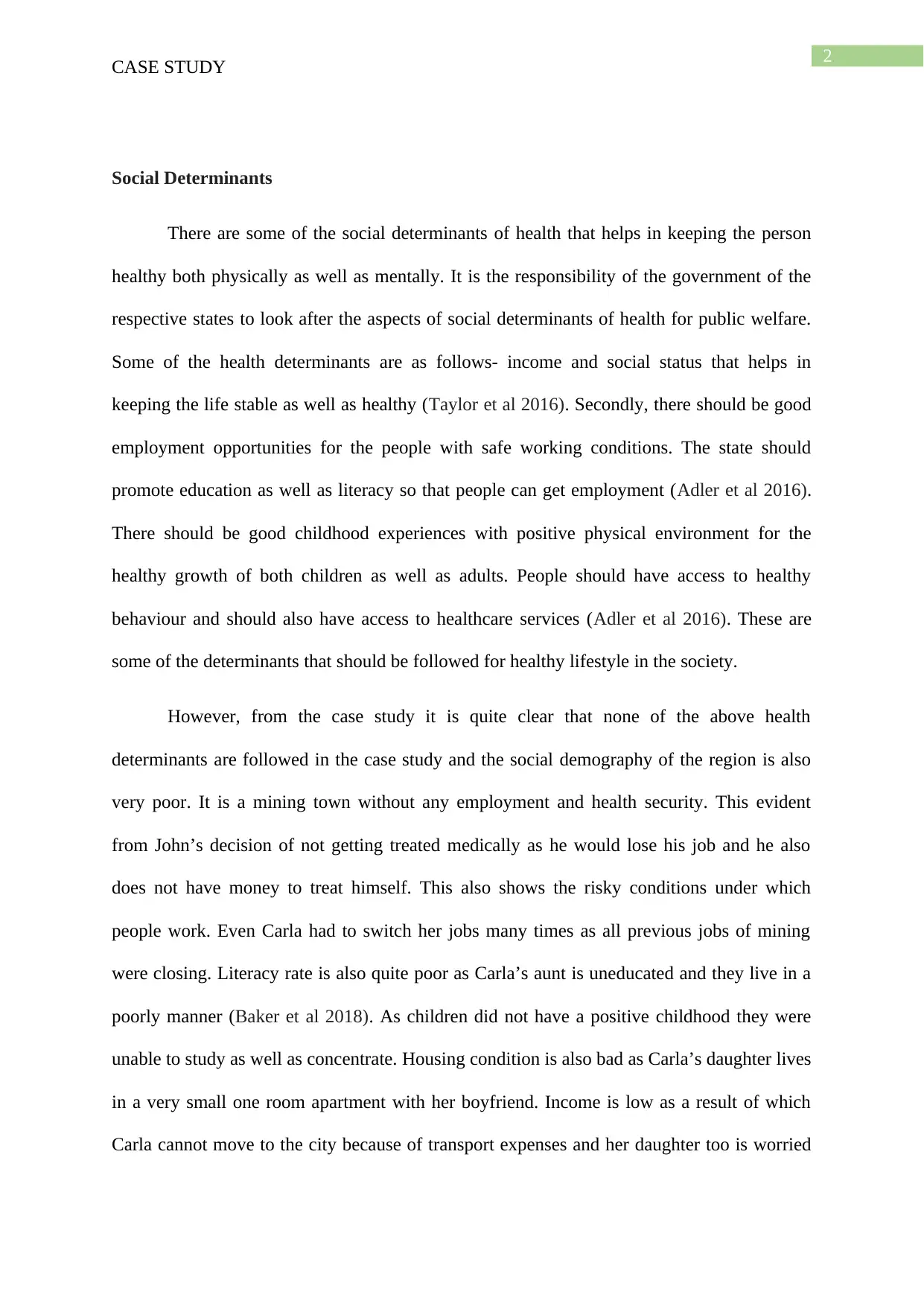
2
CASE STUDY
Social Determinants
There are some of the social determinants of health that helps in keeping the person
healthy both physically as well as mentally. It is the responsibility of the government of the
respective states to look after the aspects of social determinants of health for public welfare.
Some of the health determinants are as follows- income and social status that helps in
keeping the life stable as well as healthy (Taylor et al 2016). Secondly, there should be good
employment opportunities for the people with safe working conditions. The state should
promote education as well as literacy so that people can get employment (Adler et al 2016).
There should be good childhood experiences with positive physical environment for the
healthy growth of both children as well as adults. People should have access to healthy
behaviour and should also have access to healthcare services (Adler et al 2016). These are
some of the determinants that should be followed for healthy lifestyle in the society.
However, from the case study it is quite clear that none of the above health
determinants are followed in the case study and the social demography of the region is also
very poor. It is a mining town without any employment and health security. This evident
from John’s decision of not getting treated medically as he would lose his job and he also
does not have money to treat himself. This also shows the risky conditions under which
people work. Even Carla had to switch her jobs many times as all previous jobs of mining
were closing. Literacy rate is also quite poor as Carla’s aunt is uneducated and they live in a
poorly manner (Baker et al 2018). As children did not have a positive childhood they were
unable to study as well as concentrate. Housing condition is also bad as Carla’s daughter lives
in a very small one room apartment with her boyfriend. Income is low as a result of which
Carla cannot move to the city because of transport expenses and her daughter too is worried
CASE STUDY
Social Determinants
There are some of the social determinants of health that helps in keeping the person
healthy both physically as well as mentally. It is the responsibility of the government of the
respective states to look after the aspects of social determinants of health for public welfare.
Some of the health determinants are as follows- income and social status that helps in
keeping the life stable as well as healthy (Taylor et al 2016). Secondly, there should be good
employment opportunities for the people with safe working conditions. The state should
promote education as well as literacy so that people can get employment (Adler et al 2016).
There should be good childhood experiences with positive physical environment for the
healthy growth of both children as well as adults. People should have access to healthy
behaviour and should also have access to healthcare services (Adler et al 2016). These are
some of the determinants that should be followed for healthy lifestyle in the society.
However, from the case study it is quite clear that none of the above health
determinants are followed in the case study and the social demography of the region is also
very poor. It is a mining town without any employment and health security. This evident
from John’s decision of not getting treated medically as he would lose his job and he also
does not have money to treat himself. This also shows the risky conditions under which
people work. Even Carla had to switch her jobs many times as all previous jobs of mining
were closing. Literacy rate is also quite poor as Carla’s aunt is uneducated and they live in a
poorly manner (Baker et al 2018). As children did not have a positive childhood they were
unable to study as well as concentrate. Housing condition is also bad as Carla’s daughter lives
in a very small one room apartment with her boyfriend. Income is low as a result of which
Carla cannot move to the city because of transport expenses and her daughter too is worried
⊘ This is a preview!⊘
Do you want full access?
Subscribe today to unlock all pages.

Trusted by 1+ million students worldwide
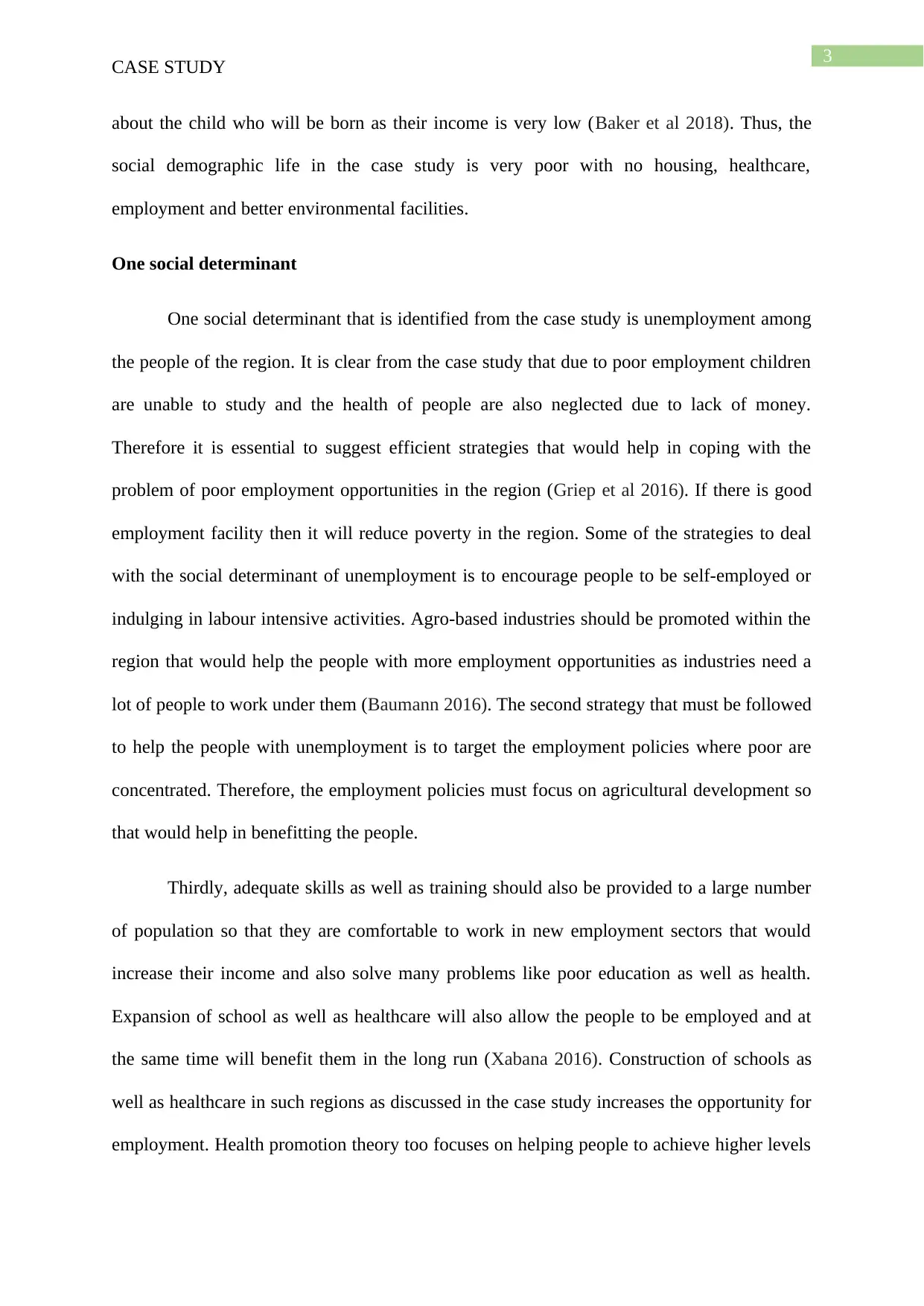
3
CASE STUDY
about the child who will be born as their income is very low (Baker et al 2018). Thus, the
social demographic life in the case study is very poor with no housing, healthcare,
employment and better environmental facilities.
One social determinant
One social determinant that is identified from the case study is unemployment among
the people of the region. It is clear from the case study that due to poor employment children
are unable to study and the health of people are also neglected due to lack of money.
Therefore it is essential to suggest efficient strategies that would help in coping with the
problem of poor employment opportunities in the region (Griep et al 2016). If there is good
employment facility then it will reduce poverty in the region. Some of the strategies to deal
with the social determinant of unemployment is to encourage people to be self-employed or
indulging in labour intensive activities. Agro-based industries should be promoted within the
region that would help the people with more employment opportunities as industries need a
lot of people to work under them (Baumann 2016). The second strategy that must be followed
to help the people with unemployment is to target the employment policies where poor are
concentrated. Therefore, the employment policies must focus on agricultural development so
that would help in benefitting the people.
Thirdly, adequate skills as well as training should also be provided to a large number
of population so that they are comfortable to work in new employment sectors that would
increase their income and also solve many problems like poor education as well as health.
Expansion of school as well as healthcare will also allow the people to be employed and at
the same time will benefit them in the long run (Xabana 2016). Construction of schools as
well as healthcare in such regions as discussed in the case study increases the opportunity for
employment. Health promotion theory too focuses on helping people to achieve higher levels
CASE STUDY
about the child who will be born as their income is very low (Baker et al 2018). Thus, the
social demographic life in the case study is very poor with no housing, healthcare,
employment and better environmental facilities.
One social determinant
One social determinant that is identified from the case study is unemployment among
the people of the region. It is clear from the case study that due to poor employment children
are unable to study and the health of people are also neglected due to lack of money.
Therefore it is essential to suggest efficient strategies that would help in coping with the
problem of poor employment opportunities in the region (Griep et al 2016). If there is good
employment facility then it will reduce poverty in the region. Some of the strategies to deal
with the social determinant of unemployment is to encourage people to be self-employed or
indulging in labour intensive activities. Agro-based industries should be promoted within the
region that would help the people with more employment opportunities as industries need a
lot of people to work under them (Baumann 2016). The second strategy that must be followed
to help the people with unemployment is to target the employment policies where poor are
concentrated. Therefore, the employment policies must focus on agricultural development so
that would help in benefitting the people.
Thirdly, adequate skills as well as training should also be provided to a large number
of population so that they are comfortable to work in new employment sectors that would
increase their income and also solve many problems like poor education as well as health.
Expansion of school as well as healthcare will also allow the people to be employed and at
the same time will benefit them in the long run (Xabana 2016). Construction of schools as
well as healthcare in such regions as discussed in the case study increases the opportunity for
employment. Health promotion theory too focuses on helping people to achieve higher levels
Paraphrase This Document
Need a fresh take? Get an instant paraphrase of this document with our AI Paraphraser
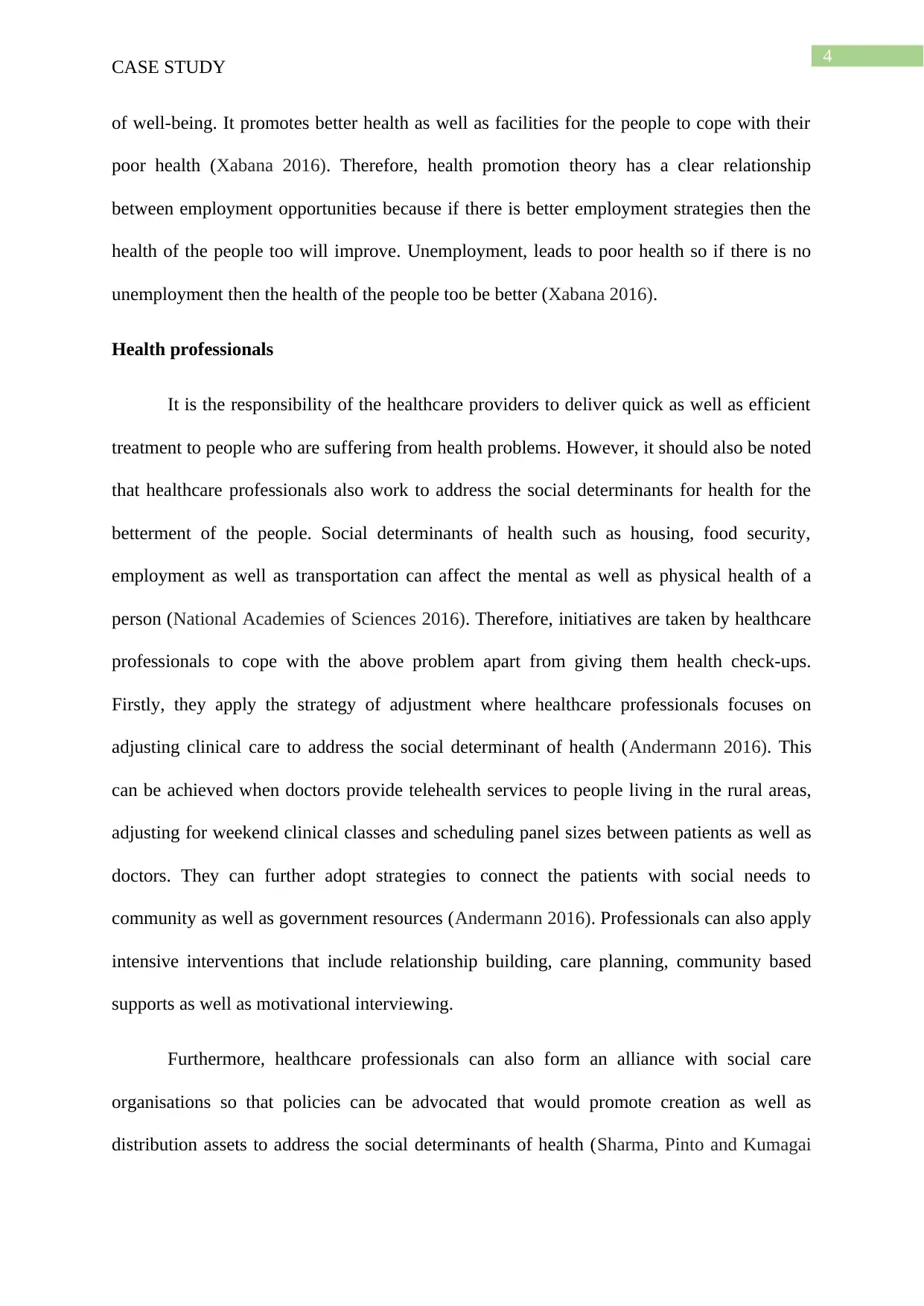
4
CASE STUDY
of well-being. It promotes better health as well as facilities for the people to cope with their
poor health (Xabana 2016). Therefore, health promotion theory has a clear relationship
between employment opportunities because if there is better employment strategies then the
health of the people too will improve. Unemployment, leads to poor health so if there is no
unemployment then the health of the people too be better (Xabana 2016).
Health professionals
It is the responsibility of the healthcare providers to deliver quick as well as efficient
treatment to people who are suffering from health problems. However, it should also be noted
that healthcare professionals also work to address the social determinants for health for the
betterment of the people. Social determinants of health such as housing, food security,
employment as well as transportation can affect the mental as well as physical health of a
person (National Academies of Sciences 2016). Therefore, initiatives are taken by healthcare
professionals to cope with the above problem apart from giving them health check-ups.
Firstly, they apply the strategy of adjustment where healthcare professionals focuses on
adjusting clinical care to address the social determinant of health (Andermann 2016). This
can be achieved when doctors provide telehealth services to people living in the rural areas,
adjusting for weekend clinical classes and scheduling panel sizes between patients as well as
doctors. They can further adopt strategies to connect the patients with social needs to
community as well as government resources (Andermann 2016). Professionals can also apply
intensive interventions that include relationship building, care planning, community based
supports as well as motivational interviewing.
Furthermore, healthcare professionals can also form an alliance with social care
organisations so that policies can be advocated that would promote creation as well as
distribution assets to address the social determinants of health (Sharma, Pinto and Kumagai
CASE STUDY
of well-being. It promotes better health as well as facilities for the people to cope with their
poor health (Xabana 2016). Therefore, health promotion theory has a clear relationship
between employment opportunities because if there is better employment strategies then the
health of the people too will improve. Unemployment, leads to poor health so if there is no
unemployment then the health of the people too be better (Xabana 2016).
Health professionals
It is the responsibility of the healthcare providers to deliver quick as well as efficient
treatment to people who are suffering from health problems. However, it should also be noted
that healthcare professionals also work to address the social determinants for health for the
betterment of the people. Social determinants of health such as housing, food security,
employment as well as transportation can affect the mental as well as physical health of a
person (National Academies of Sciences 2016). Therefore, initiatives are taken by healthcare
professionals to cope with the above problem apart from giving them health check-ups.
Firstly, they apply the strategy of adjustment where healthcare professionals focuses on
adjusting clinical care to address the social determinant of health (Andermann 2016). This
can be achieved when doctors provide telehealth services to people living in the rural areas,
adjusting for weekend clinical classes and scheduling panel sizes between patients as well as
doctors. They can further adopt strategies to connect the patients with social needs to
community as well as government resources (Andermann 2016). Professionals can also apply
intensive interventions that include relationship building, care planning, community based
supports as well as motivational interviewing.
Furthermore, healthcare professionals can also form an alliance with social care
organisations so that policies can be advocated that would promote creation as well as
distribution assets to address the social determinants of health (Sharma, Pinto and Kumagai
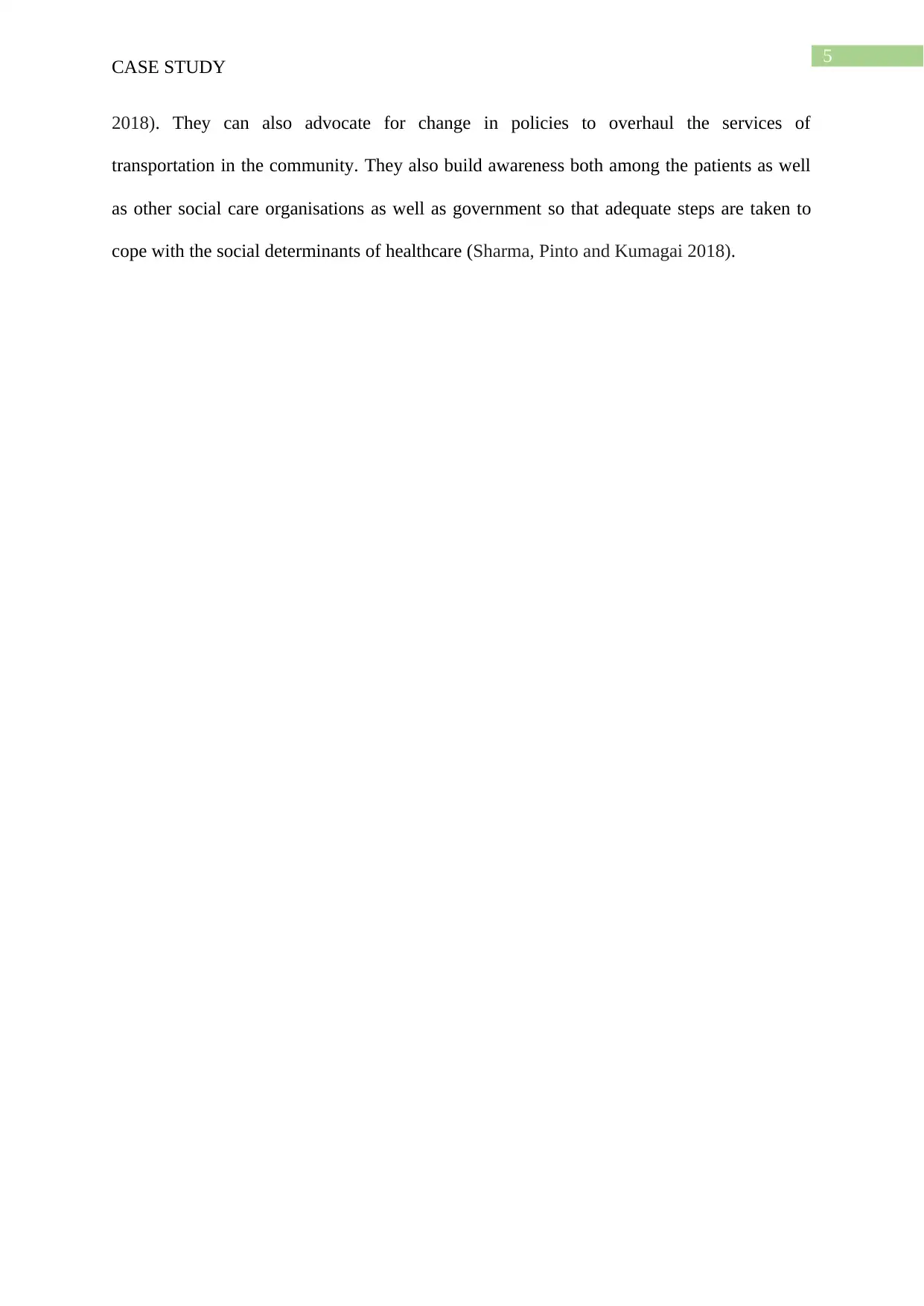
5
CASE STUDY
2018). They can also advocate for change in policies to overhaul the services of
transportation in the community. They also build awareness both among the patients as well
as other social care organisations as well as government so that adequate steps are taken to
cope with the social determinants of healthcare (Sharma, Pinto and Kumagai 2018).
CASE STUDY
2018). They can also advocate for change in policies to overhaul the services of
transportation in the community. They also build awareness both among the patients as well
as other social care organisations as well as government so that adequate steps are taken to
cope with the social determinants of healthcare (Sharma, Pinto and Kumagai 2018).
⊘ This is a preview!⊘
Do you want full access?
Subscribe today to unlock all pages.

Trusted by 1+ million students worldwide
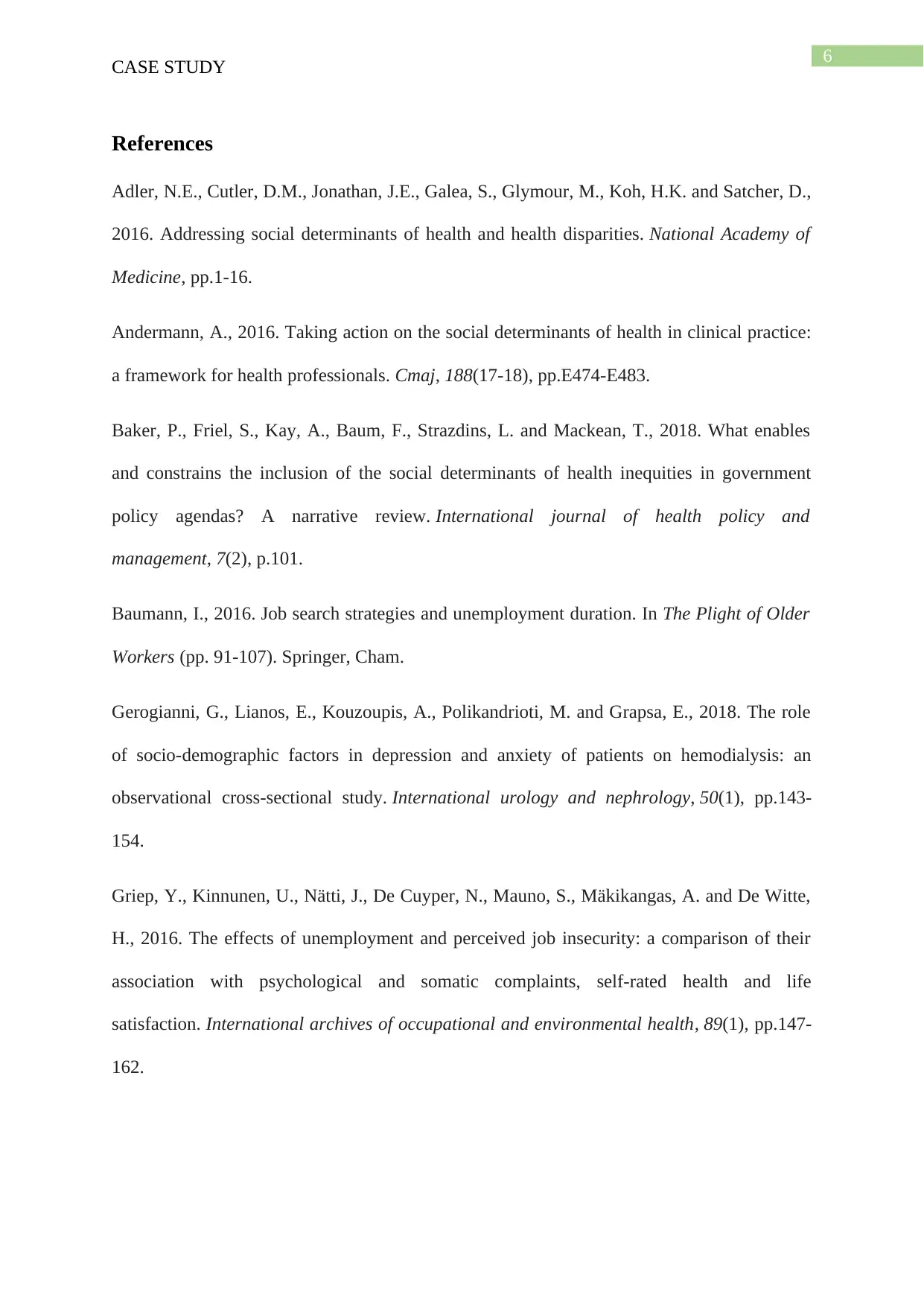
6
CASE STUDY
References
Adler, N.E., Cutler, D.M., Jonathan, J.E., Galea, S., Glymour, M., Koh, H.K. and Satcher, D.,
2016. Addressing social determinants of health and health disparities. National Academy of
Medicine, pp.1-16.
Andermann, A., 2016. Taking action on the social determinants of health in clinical practice:
a framework for health professionals. Cmaj, 188(17-18), pp.E474-E483.
Baker, P., Friel, S., Kay, A., Baum, F., Strazdins, L. and Mackean, T., 2018. What enables
and constrains the inclusion of the social determinants of health inequities in government
policy agendas? A narrative review. International journal of health policy and
management, 7(2), p.101.
Baumann, I., 2016. Job search strategies and unemployment duration. In The Plight of Older
Workers (pp. 91-107). Springer, Cham.
Gerogianni, G., Lianos, E., Kouzoupis, A., Polikandrioti, M. and Grapsa, E., 2018. The role
of socio-demographic factors in depression and anxiety of patients on hemodialysis: an
observational cross-sectional study. International urology and nephrology, 50(1), pp.143-
154.
Griep, Y., Kinnunen, U., Nätti, J., De Cuyper, N., Mauno, S., Mäkikangas, A. and De Witte,
H., 2016. The effects of unemployment and perceived job insecurity: a comparison of their
association with psychological and somatic complaints, self-rated health and life
satisfaction. International archives of occupational and environmental health, 89(1), pp.147-
162.
CASE STUDY
References
Adler, N.E., Cutler, D.M., Jonathan, J.E., Galea, S., Glymour, M., Koh, H.K. and Satcher, D.,
2016. Addressing social determinants of health and health disparities. National Academy of
Medicine, pp.1-16.
Andermann, A., 2016. Taking action on the social determinants of health in clinical practice:
a framework for health professionals. Cmaj, 188(17-18), pp.E474-E483.
Baker, P., Friel, S., Kay, A., Baum, F., Strazdins, L. and Mackean, T., 2018. What enables
and constrains the inclusion of the social determinants of health inequities in government
policy agendas? A narrative review. International journal of health policy and
management, 7(2), p.101.
Baumann, I., 2016. Job search strategies and unemployment duration. In The Plight of Older
Workers (pp. 91-107). Springer, Cham.
Gerogianni, G., Lianos, E., Kouzoupis, A., Polikandrioti, M. and Grapsa, E., 2018. The role
of socio-demographic factors in depression and anxiety of patients on hemodialysis: an
observational cross-sectional study. International urology and nephrology, 50(1), pp.143-
154.
Griep, Y., Kinnunen, U., Nätti, J., De Cuyper, N., Mauno, S., Mäkikangas, A. and De Witte,
H., 2016. The effects of unemployment and perceived job insecurity: a comparison of their
association with psychological and somatic complaints, self-rated health and life
satisfaction. International archives of occupational and environmental health, 89(1), pp.147-
162.
Paraphrase This Document
Need a fresh take? Get an instant paraphrase of this document with our AI Paraphraser
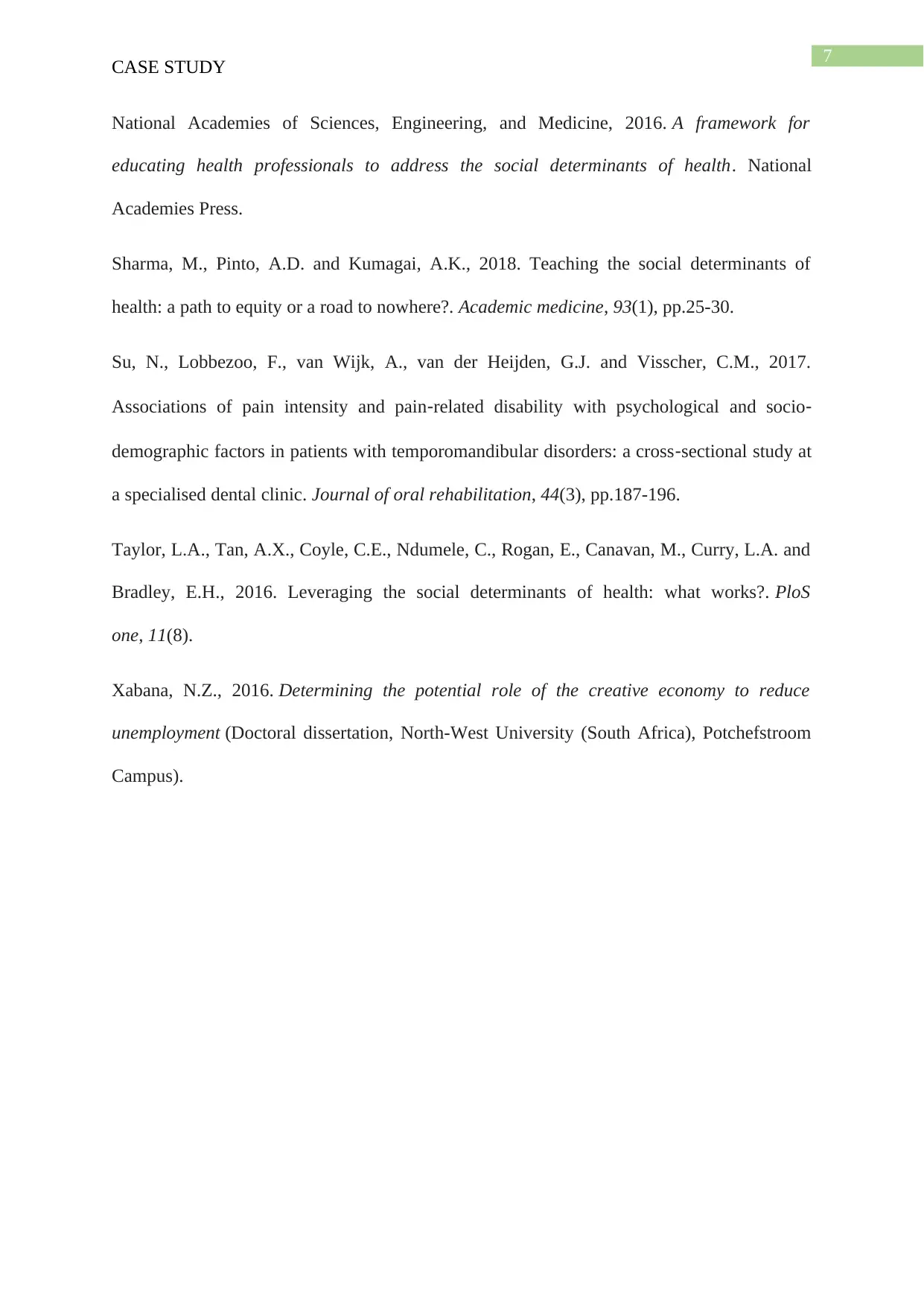
7
CASE STUDY
National Academies of Sciences, Engineering, and Medicine, 2016. A framework for
educating health professionals to address the social determinants of health. National
Academies Press.
Sharma, M., Pinto, A.D. and Kumagai, A.K., 2018. Teaching the social determinants of
health: a path to equity or a road to nowhere?. Academic medicine, 93(1), pp.25-30.
Su, N., Lobbezoo, F., van Wijk, A., van der Heijden, G.J. and Visscher, C.M., 2017.
Associations of pain intensity and pain‐related disability with psychological and socio‐
demographic factors in patients with temporomandibular disorders: a cross‐sectional study at
a specialised dental clinic. Journal of oral rehabilitation, 44(3), pp.187-196.
Taylor, L.A., Tan, A.X., Coyle, C.E., Ndumele, C., Rogan, E., Canavan, M., Curry, L.A. and
Bradley, E.H., 2016. Leveraging the social determinants of health: what works?. PloS
one, 11(8).
Xabana, N.Z., 2016. Determining the potential role of the creative economy to reduce
unemployment (Doctoral dissertation, North-West University (South Africa), Potchefstroom
Campus).
CASE STUDY
National Academies of Sciences, Engineering, and Medicine, 2016. A framework for
educating health professionals to address the social determinants of health. National
Academies Press.
Sharma, M., Pinto, A.D. and Kumagai, A.K., 2018. Teaching the social determinants of
health: a path to equity or a road to nowhere?. Academic medicine, 93(1), pp.25-30.
Su, N., Lobbezoo, F., van Wijk, A., van der Heijden, G.J. and Visscher, C.M., 2017.
Associations of pain intensity and pain‐related disability with psychological and socio‐
demographic factors in patients with temporomandibular disorders: a cross‐sectional study at
a specialised dental clinic. Journal of oral rehabilitation, 44(3), pp.187-196.
Taylor, L.A., Tan, A.X., Coyle, C.E., Ndumele, C., Rogan, E., Canavan, M., Curry, L.A. and
Bradley, E.H., 2016. Leveraging the social determinants of health: what works?. PloS
one, 11(8).
Xabana, N.Z., 2016. Determining the potential role of the creative economy to reduce
unemployment (Doctoral dissertation, North-West University (South Africa), Potchefstroom
Campus).
1 out of 8
Related Documents
Your All-in-One AI-Powered Toolkit for Academic Success.
+13062052269
info@desklib.com
Available 24*7 on WhatsApp / Email
![[object Object]](/_next/static/media/star-bottom.7253800d.svg)
Unlock your academic potential
Copyright © 2020–2025 A2Z Services. All Rights Reserved. Developed and managed by ZUCOL.





